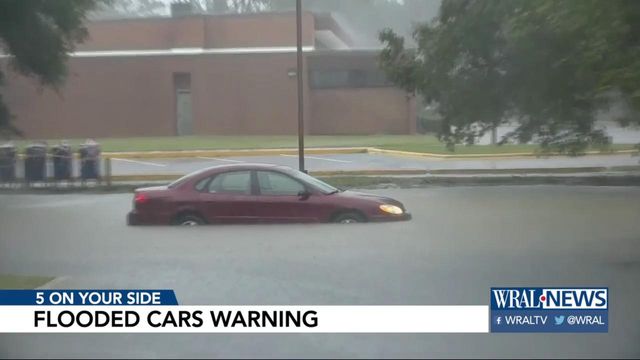To avoid flood-damaged used cars, inspect with sight, smell, touch
Flooded cars – damaged in a hurricane or other storm and moved from state to state to be re-sold – are a danger during hurricane season. A Fort Bragg soldier reached out to 5 On Your Side with a warning after his recent experience on a local car lot.
Chris Francis found a used pick-up truck online and went to look at it last week at a Fayetteville dealership.
"From a distance, it looked like it was in great shape," he said.
"When we opened the door, there was a real distinct smell of mildew and the carpet was wet," he said. "(There were) leaves, pine needles, sticks things like that and you could actually see the water line. There was water inside the headlights."
A dealership spokesman told 5 On Your Side that the truck had not been flooded. He said the the carpet was wet from being shampooed, and he added that the vehicle was "detailed too hard."
Francis was smart to be suspicious because it's likely flooded cars are already on the market after Hurricane Florence. In North Carolina, even though it's illegal to sell a flooded vehicle without disclosing the damage, it still happens.
Buyers should do a thorough check on any used vehicle. Jon Linkov, of Consumer Reports, recommends using sight, touch and smell.
"The first thing you want to do is come over to the front of the car. Inhale and see if there's any kind of moldy or musty smell. If you have that you definitely want to walk away from the car," he said.
"Next, pop up the trim panel on the side of the door to see if the carpet is dirty or if there's any kind of sediment in here or rust.
"Also look in the door pockets. If there's any kind of sediment in here or dirt or stones, that's what happened when the water came up and into the car, and as it drained away it settled and hid in there.
"Pop off some of the caps and covers for the seat bolts. If these are scratched up or even look rusted, that means the seat was taken out so it could air dry.
"Look where a spare tire would be kept. Smell if it's musty or moldy smelling. See if there's any rust on exposed screws, on the panels or even on the tools like the jack or the jack stand.
"Look along the back of the engine bay, and there's some soft material here, it's sound deadening. When water rises and stays when the car is flooded, it's going to recede and leave a flood line. If there's anything like that, walk away from the vehicle."
If a car passes those tests, take it to a trusted mechanic for a professional inspection.
Consumer Reports warns that vehicle history reports, although helpful, are no guarantee a car is problem-free.











